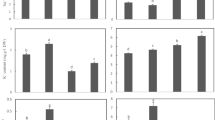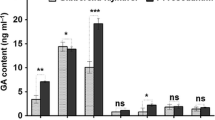Abstract
An endophytic fungus was isolated from the roots of tomato (Solanum lycopersicum Mill) and identified as Penicillium janthinellum LK5. The culture filtrate (CF) of P. janthinellum significantly increased the shoot length of gibberellins (GAs) deficient mutant waito-c and normal Dongjin-beyo rice seedlings as compared to control. The CF of P. janthinellum contained GAs (GA3, GA4, GA7 and GA12). To assess endophyte-growth promoting and stress-tolerance potential, the CF along with the propagules of endophyte was applied to tomato-host and abscisic acid (ABA)-deficient mutant Sitiens plants under sodium chloride (NaCl) induced salinity stress. Sitiens plants had retarded growth under normal and salinity stress however its growth was much improved during P. janthinellum-association. The endophyte inoculation reduced the membrane injury by decreasing lipid peroxidation as compared to non-inoculated control under salinity. Endophyte-associated Sitiens plants have significantly higher catalase, peroxidase and glutathione activities as compared to control. Endophyte-infected host and Sitiens plants had low level of sodium ion toxicity and high calcium contents in its root as compared to control. P. janthinellum LK5 helped the Sitiens plants to synthesis significantly higher ABA and reduced the level of jasmonic acid to modulate stress responses. The results suggest that endophytes-association can resist salinity stress by producing gibberellins and activating defensive mechanisms of host and Sitiens plants to achieve improved growth.






Similar content being viewed by others
References
Aebi H (1984) Catalase in vitro. Meth Enzymol 105:121–127
Bomke C, Rojas MC, Gong F, Hedden P, Tudzynski B (2008) Isolation and characterization of the gibberellin biosynthetic gene cluster in Sphaceloma manihoticola. Appl Environ Microbiol 74:5325–5339
Bussaban B, Lumyong S, Lumyong P, McKenzie EHC, Hyde KD (2001) Endophytic fungi of Amomum siamense from Doi Suthep Pui, Thailand. Can J Microbiol 47:943–948
Choi WY, Rim SO, Lee JH, Lee JM, Lee IJ, Cho KJ, Rhee IK, Kwon JB, Kim JG (2005) Isolation of gibberellins producing fungi from the root of several Sesamum indicum plants. J Microbiol Biotechnol 15:22–28
Coleman JS, Schneider KM (1996) Evidence that abscisic acid does not regulate a centralized whole-plant response to low soil-resource availability. Oecologia 106:277–283
Cramer GR (2002) Response of ABA mutants of Arabidopsis to salinity. Funct Plant Biol 29:561–567
Elena GJ, Beatriz PJ, Alejandro P, Lecuona RE (2011) Metarhizium anisopliae (Metschnikoff) Sorokin Promotes Growth and Has Endophytic Activity in Tomato Plants. Adv Biol Res 5(1):22–27
Ellman GL (1959) Tissue sulfhydryl groups. Arch Biochem Biophys 82:70–77
Esterbauer H, Cheeseman KH (1990) Determination of aldehydic lipid peroxidation products: malonaldehyde and 4-hydroxynonenal. Meth Enzymol 186:407–421
Grillo S, Leone A, Xu Y, Tucci M, Francione R, Hasegawa PM, Monti L, Bressan RA (1995) Control of osmotin gene expression by ABA and osmotic stress in vegetative tissues of wild-type and ABA-deficient mutants of tomato. Physiol Plantarum 93(3):498–504
Hamayun M, Khan SA, Iqbal I, Hwang YH, Shin DH, Sohn EY, Lee BH, Na CI, Lee IJ (2009) Chrysosporium pseudomerdarium produces gibberellins and promotes plant growth. J Microbiol 47:425–430
Hamayun M, Khan SA, Iqbal I, Ahmad B, Lee IJ (2010) Isolation of a Gibberellin-producing fungus (Penicillium sp. MH7) and growth promotion of crown daisy (Chrysanthemum coronarium). J Microbiol Biotechnol 20:202–209
Harrison E, Burbidge A, Okyere J, Thompson A, Taylor I (2011) Identification of the tomato ABA-deficient mutant sitiens as a member of the ABA-aldehyde oxidase gene family using genetic and genomic analysis. Plant Growth Reg 64:301–309
Hause B, Schaarschmidt S (2009) The role of jasmonates in mutualistic symbioses between plants and soil-born microorganisms. Phytochem 70:1589–1599
Herde O, Peña-Cortés H, Willmitzer L, Fisahn J (1997) Stomatal responses to jasmonic acid, linolenic acid and abscisic acid in wild-type and ABA-deficient tomato plant. Plant Cell Eviron 20:136–141
Herde O, Peña-Cortés H, Wasternack C, Willmitzer L, Fisahn J (1999) Electric signaling and Pin2 gene expression on different abiotic stimuli depend on a distinct threshold level of endogenous abscisic acid in several abscisic acid deficient tomato mutants. Plant Physiol 1190:213–218
Herrera-Medina MJ, Steinkellner S, Vierheilig H, Ocampo JA, Garcı′a Garrido JM (2007) Abscisic acid determinates arbuscule development and functionality in the tomato arbuscular mycorrhiza. New Phytol 175:554–564
Hussain TM, Chandrasekhar T, Hazara M, Sultan Z, Saleh BK, Gopal GR (2008) Recent a dvances in salt stress biology. Biotechnol Molecular Biol 3:008–013
Hyde KD, Doytong K (2008) The fungal endophyte dilemma. Fungal Divers 33:163–173
Ikeda A, Ueguchi-Tanaka M, Sonoda Y, Kitano H, Koshioka M, Futsuhara Y, Matsuoka M, Yamaguchi J (2001) Slender rice, a constitutive gibberellin response mutant, is caused by a null mutation of the SLR1 gene, an ortholog of the height-regulating gene GAI/RGA/RHT/D8. Plant Cell 13:999–1010
Jahromi F, Aroca R, Porcel R, Ruiz-Lozano JM (2008) Influence of salinity on the in vitro development of Glomus intraradices and on the in vivo physiological and molecular responses of mycorrhizal lettuce plants. Microbial Eco 55:45–53
Kamboj JS, Blake PS, Quinlan JD, Baker DA (1999) Identification and quantitation by GC–MS of zeatin and zeatin riboside in xylem sap from rootstock and scion of grafted apple trees. Plant Growth Regul 28:199–205
Kar M, Mishra D (1976) Catalase, peroxidase, and polyphenoloxidase activities during rice leaf senescence. Plant Physiol 57:315–319
Kawaide H (2006) Biochemical and molecular analysis of gibberellins biosynthesis in fungi. Biosci Biotech Biochem 70:583–590
Khan SA, Hamayun M, Yoon HJ, Kim YH, Suh SJ, Hwang SK (2008) Plant growth promotion and Penicillium citrinum. BMC Microbiol 8:231
Khan AL, Hamayun M, Ahmad N, Hussain J, Kang SM, Kim YH, Adnan M, Tang DH, Waqas M, Radhakrishnan R, Park ES, Lee IJ (2011a) Salinity stress resistance offered by endophytic fungal interaction between Penicillium minioluteum LHL09 and Glycine max L. J Microbiol Biotech 21(9):893–902
Khan AL, Hamayun M, Kim YH, Kang SM, Lee IJ (2011b) Ameliorative symbiosis of endophyte (Penicillium funiculosum LHL06) under salt stress elevated plant growth of Glycine max L. Plant Physiol Biochem 49:852–862
Khan AL, Hamayun M, Kang SM, Kim YH, Jung HY, Lee JH, Lee IJ (2012) Endophytic fungal association via gibberellins and indole acetic acid can improve plant growth under abiotic stress: an example of Paecilomyces formosus LHL10. BMC Microbiol 12:3–14
Kim HY, Choi GJ, Lee HB, Lee SW, Lim HK, Jang KS, Son SW, Lee SO, Cho KY, Sung ND, Kim JC (2007) Some fungal endophytes from vegetable crops and their anti-oomycete activities against tomato late blight. Lett Appl Microbiol 44:332–337
Kumar M, Sharma R, Jogawat A, Singh P, Dua M, Gill SS, Trivedi DK, Tuteja N, Verma AK, Oelmuller R, Johri AK (2012) Piriformospora indica, A root endophytic fungus, enhances abiotic stress tolerance of the host plant. In: Improving crop resistance to abiotic stress. Wiley-VCH Verlag GmbH & Co., Germany, pp 231–234
Larran S, Monaco C, Alippi HE (2001) Endophytic fungi in leaves of Lycopersicon esculentum Mill. WJ Microb Biotech 17:181–184
Lee IJ, Foster K, Morgan PW (1998) Photoperiod control of gibberellin levels and flowering in sorghum. Plant Physiol 116:1003–1011
Mäkeläa P, Munnsb R, Colmerc TD, Peltonen-Sainio P (2003) Growth of tomato and an ABA-deficient mutant (sitiens) under saline Conditions. Physiol Plantarum 117:58–63
Massaccesi G, Romero MC, Cazau MC, Bucsinszky AM (2002) Cadmium removal capacities of filamentous soil fungi isolated from industrially polluted sediments, in La Plata (Argentina). WJ Microb Biotech 18:817–820
Mauch-Mani B, Mauch F (2005) The role of abscisic acid in plant pathogen interactions. Curr Opin Plant Biol 8:409–414
McCloud ES, Baldwin IT (1997) Herbivory and caterpillar regurgitants amplify the wound induced increases in jasmonic acid but not nicotine in Nicotiana sylvestris. Planta 203:430–435
Miransari M, Prasad MNV (2012) Role of phytohormone signaling during stress environmental adaptations and stress tolerance of plants in the era of climate change. Springer, New York
Mittler R, Vanderauwera S, Gollery M, Van Breusegem F (2004) The reactive oxygen gene network of plants. Trends Plant Sciences 9:490–498
Nagel OW, Konings H, Lambers H (1994) Growth rate, plant development and water relations of the ABA-deficient mutant sitiens. Physiol Plantarum 92:102–108
Obura (2010) Root endophytic fungi of tomato and their role as biocontrol agents of root-knot nematodes Meloidogyne incognita (Kofoid and white) Chitwood and growth promotion in tomato plants (Lycopersicon esculentum Mill), Bruce Ochieng
Ohkawa H, Ohishi N, Yagi K (1979) Assay of lipid peroxides in animal tissue by thiobarbituric acid reaction. Ann Biochem 95:351–358
Pedranzani H, Racagni G, Alemano S, Miersch O, Ramırez I, Pena-Cortes H, Taleisnik E, Machado-Domenech E, Abdala G (2003) Salt tolerant tomato plants show increased levels of jasmonic acid. Plant Growth Regul 41:149–158
Peleg Z, Blumwald E (2011) Hormone balance and abiotic stress tolerance in crop plants. Curr Opin Plant Biol 14:290–295
Rademacher W (1994) Gibberellin formation in microorganisms. Plant Growth Regul 15(303):314
Redman RS, Kim YO, Woodward CJDA, Greer C, Espino L (2011) Increased fitness of rice plants to abiotic stress via habitat adapted symbiosis: a strategy for mitigating impacts of climate change. PLoS ONE 6:e14823
Reid JB (1990) Phytohormone mutants in plant research. J Plant Growth Regul 9:97–111
Rodriguez JAM, Morcillo R, Vierheilig H, Ocampo JA, Ludwig-Muller J, Jose′ Garrido MG (2010) Mycorrhization of the notabilis and sitiens tomato mutants in relation to abscisic acid and ethylene contents. J Plant Physiol 167:606–613
Rodriguez RJ, Woodward CJ, Redman RS (2012) Fungal influence on plant tolerance to stress, in biocomplexity of plant-fungal interactions. Wiley, UK
Sairam RK, Tyagi A (2004) Physiology and molecular biology of salinity stress tolerance in plants. Current Sci 86(3):15–20
Schulz B, Boyle C (2005) The endophytic continuum. Mycol Res 109:661–686
Schulz B, Boyle C, Draeger S, Rommert AK, Krohn K (2002) Endophytic fungi: a source of biologically active secondary metabolites. Mycol Res 106:996–1004
Schützendübel A, Polle A (2002) Plant responses to abiotic stresses: heavy metal-induced oxidative stress and protection by mycorrhization. J Exper Bot 53:1351–1365
Sharp RE, LeNoble ME, Else MA, Thorne ET, Gherardi F (2000) Endogenous ABA maintains shoot growth in tomato independently of effects on plant water balance: evidence for an interaction with ethylene. J Exper Bot 51:1575–1584
Sherameti I, Tripathi S, Varma A, Oelmüller R (2008) The root-colonizing endophyte Piriformospora indica confers drought tolerance in arabidopsis by stimulating the expression of drought stress–related genes in leaves. MPMI 21:799–807
Taylor IB, Linforth RST, Al-Naieb RJ, Bowman WR, Marples BA (1988) Thewiltytomato mutants flacca and sitiens are impaired in the oxidation of ABA-aldehyde to ABA. Plant, Cell Environ 11:739–745
Tehler A (1995) Morphological data, molecular data, and total evidence in phylogenetic analysis. Can J Bot 73:667–676. doi:10.1139/b95-309
Waller F, Achatz B, Baltruschat H, Fodor J, Becker K, Fischer M, Heier T, Huckelhoven R, Neumann C, Von Wettstein D, Franken P, Kogel KH (2005) The endophytic fungus Piriformospora indica reprograms barley to salt-stress tolerance, disease resistance, and higher yield. PNAS 102:13386–13391
Wang Y, Mopper S, Karl H (2001) Effects of salinity on endogenous ABA, IAA, JA, and SA in iris hexagona. J Chem Eco 27:220–224
Waqas M, Khan AL, Kamran M, Hamayun M, Kang S-M, Kim Y-H, Lee I-J (2012) Endophytic fungi produce gibberellins and indoleacetic acid and promotes host-plant growth during Stress. Molecules 17(9):10754–10773
White PJ, Broadley MR (2003) Calcium in Plants. Ann Bot 92:487–511
Yuan ZL, Zhang CL, Lin FC (2010) Role of diverse non-systemic fungal endophytes in plant performance and response to stress: progress and approaches. J Plant Growth Regul 29:116–126
Acknowledgments
This research was supported by Basic Science Research Program through the National Research Foundation of Korea (NRF) funded by the Ministry of Education, Science and Technology (2012R1A6A3A01040552 and 2011-0022027).
Author information
Authors and Affiliations
Corresponding author
Electronic supplementary material
Below is the link to the electronic supplementary material.
Rights and permissions
About this article
Cite this article
Khan, A.L., Waqas, M., Khan, A.R. et al. Fungal endophyte Penicillium janthinellum LK5 improves growth of ABA-deficient tomato under salinity. World J Microbiol Biotechnol 29, 2133–2144 (2013). https://doi.org/10.1007/s11274-013-1378-1
Received:
Accepted:
Published:
Issue Date:
DOI: https://doi.org/10.1007/s11274-013-1378-1




